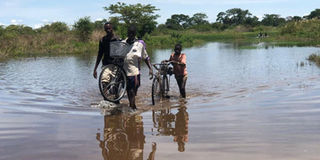Government raises red flag over rising water levels

Against all odds. Residents wade through a flooded section of Morem Road in Kobulubulu Sub-county, Kaberamaido District, on April 1. PHOTO BY BILL OKETCH
Government has raised the red flag over the rapid rising water levels on lake shores and river banks.
People settling around such areas have been advised to vacate immediately to avert a looming calamity.
The Ministry of Water and Environment, while issuing a warning notice on Friday, indicated that the rapid raising water levels on Lake Kyoga could cause devastating consequences for the districts sharing the lake.
Mr Alfred Okot Okidi, the Permanent Secretary at the Ministry of Water and Environment, said Lake Victoria and Lake Kyoga are expanding and continue to reclaim their territories.
“The river is coming back to its home, even those swamps are coming back to their homes. So, we should not look at it as an invasion, they are reclaiming their home,” Mr Okot said at Kaberamaido District headquarters. The districts which share Lake Kayoga include Nakasongola, Pallisa, Amolatar, Kamuli, Apac, Dokolo, Buyende, Kaliro, Soroti, Kaberamaido, Serere, Katakwi, Ngora, Dokolo, and Kumi.
Currently, many people have been affected by floods as the country’s reservoir: Lake Victoria and Lake Kyoga continue filling up rapidly.
Kaberamaido District chairperson Albert Anthony Ejoku said: “Gardens and homes near swamps have already been submerged.”
He said they were in the process of documenting the affected households so that the list could be submitted to relevant ministries for support.
On Friday, a team from the Ministry of Water and Environment conducted an assessment on the effect of the rising water levels in Lira, Dokolo, Kaberamaido and Serere districts.
During the one-day long exercise, it was established that more than 2,000 people in Morem Parish, Kobulubulu Sub-county in Kaberamaido have been cut off from the rest of the country by floods. The worst affected villages included Nasebwe and Kitoko.
A retired teacher, Alex Otim, said more than 50 households in Morem Parish had been displaced and dozens of houses and gardens submerged.
In Serere, more than 5,000 people in 29 villages in Bugondo Sub-county have been affected by the floods, the area LC3 chairperson, Mr Apollo Ewidu, said.
Crops such as maize, sorghum, millet, simsim, cassava, pigeon peas, and potatoes have also been submerged. Other sub-counties in Serere including Kadungulu, Labwor, Kateta, Kyere and Pingire were also affected by floods.
In Ntoroko District, at least 400 families have been displaced and their property destroyed as a result of rising water levels in Lake Albert. Local residents said the problem started in October last year but has worsened this year following heavy rains in April.
In February, most landing sites closed downstream in Buliisa District after River Semuliki carried sediments from upstream catchments in Bundibugyo and Ntoroko districts that caused Lake Albert to flood thereby paralysing business.
The executive director of National Environment Management Authority (Nema), Dr Tom Okurut, said: “The only solution is that people have to stop staying around river banks.”
Ms Beatrice Anywar, the State minister for Environment, said: “If you are found in forest reserves, wetlands, shorelines, we are going to evict you with immediate effect and you will not be compensated,” she said.
Mr Richard Musota, the manager of Upper Nile Water Management Zone, blamed the rapid rising water levels on human interference on the water bodies.


